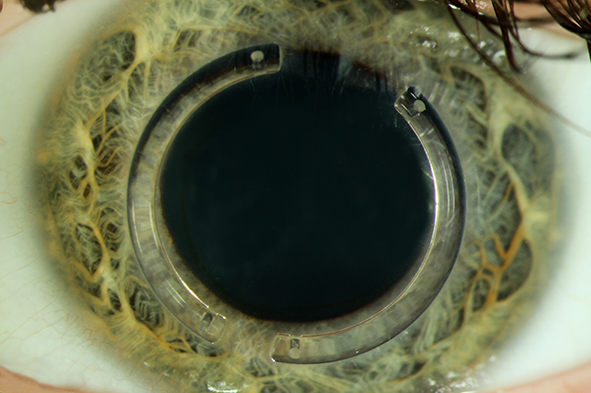The Homburg Keratoconus Center HKC
The Homburg Keratoconus Center (HKC) was established 10 years ago. Its primary goal is to examine all patients suffering from keratoconus in a standardized way and to document long-term courses. Furthermore, patients with thyroid dysfunction are included and undergo the same examinations for keratoconus diagnosis in order to evaluate the interaction of both diseases. A special focus will be on the investigation of the potential association of hypothyroidism and keratoconus, especially also in patients with Down syndrome, and the influence of contact lens wear on the progression of the disease. After a written consent, the patient can be admitted to the HKC. In addition to a visual acuity survey without and with correction and biomicroscopic examination, examinations of the entire anterior segment of the eye are performed using PentacamHR, TMS-5, anterior segment OCT CASIA2 and IOL-Master. Since September 2017, we also take into account the biomechanical parameters of CORVIS. Previously, we had the Keratoconus Match Index KMI of the Ocular Response Analyzer ORA at our disposal. Furthermore, the skiascope reflex and the objective refraction are collected. Patients complete a questionnaire on general and ophthalmologic history, medications, and daily habits (e.g., smoking, eye rubbing, contact lens wear) and undergo blood sampling to determine thyroid status (TSH, T3, T4, TPO-AK, IgE). So far, almost 1900 patients have been registered in a relational database developed together with the Institute of Experimental Ophthalmology of Saarland University (Head: Prof. Dr. Achim Langenbucher). At present we are developing - after extensive reproducibility studies - a biomechanical staging of keratoconus, which is closely based on the ABCD grading system according to Belin and Duncan. Patients initially present to our cornea consultation every six months, and annually if the findings are stable (3 patients have come for checkups 15 times). Since October 2020, we have been collaborating with the Keratoconus International Consortium (KIC) in Melbourne, Australia.
Background
Keratoconus is a serious corneal disease that typically begins during puberty and is associated with thinning and bulging forward. Often, the condition is noticeable by deterioration of vision. Approximately 1 in 2000 of the population in Europe is affected by the disease (in Far Eastern and South Asian regions the incidence is significantly higher). The average age of diagnosis in Europe is about 28 years, of which about 60% of men are affected. Usually, the disease occurs in both eyes and progresses until the 3rd or 4th decade of life, after which arrest often occurs. Treatment is initially with hard contact lenses to compensate for declining visual acuity. For some patients, riboflavin crosslinking or implantation of intracorneal ring segments may be considered as a treatment option to halt the progression of the disease. For other patients, only lamellar (DALK) or perforating (PKP) corneal transplantation remains to improve visual acuity. For both DALK and PKP, the incision in Homburg is routinely non-contact excimer laser-assisted without compression or distortion.



